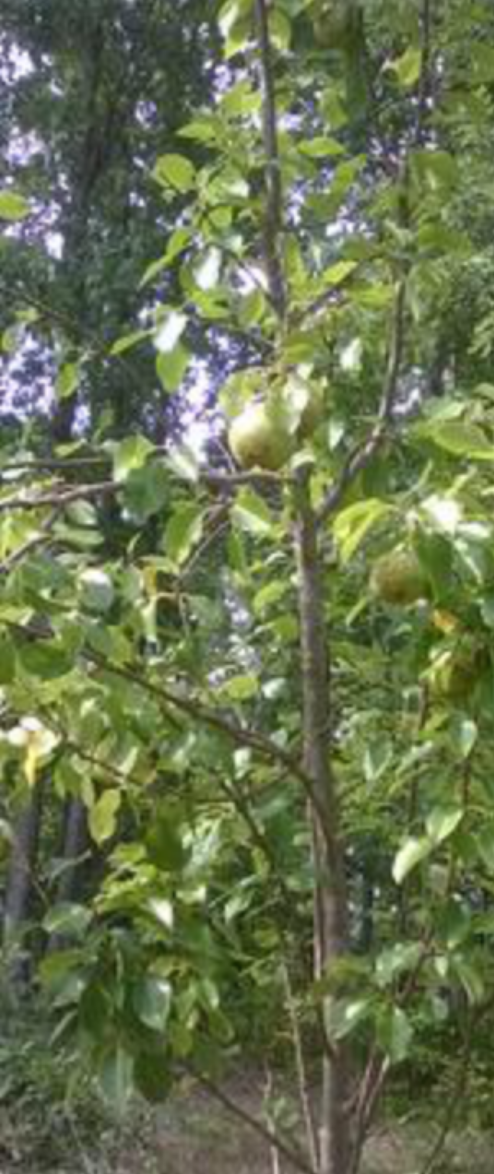Fruit Tree Maintenance
Fruit tree maintenance consists of:
- Pruning
- Mulching
- Fertilization
- Watering
- Disease & Insect Control
Whole books have been written about this subject so this is just a bare bones practical minimum guide. Except for spraying and summer watering the majority of wildlife fruit tree orchard maintenance is completed just before spring flowering of the trees. The assumption is that you have planted the wildlife fruit tree orchards in a perennial food plot of clover or clover and chicory.
Early to Mid-March Maintenance: (Performed at one time)
Pruning: Make cuts when applicable just above a bud with the cut on a angle
- Remove dead wood
- Remove broken limbs
- Remove the branch that looks least benefecial when 2 limbs overlap and touch
- Cut back multiple leaders on all trees except shrub type fruit trees like Chickasaw Plums
- Remove suckers at or near the base of the trunks
A primary goal of pruning is to open up the tree for sunlight. Use offset pruners. We usually have a quality pair in stock if you need a pair. Just be conservative on cutting the first few attempts. Put the pruned limbs in a bag and get rid of them away from your trees.
Fertilization:
- We fertilize the clover with a brodcast spreader at somewhere between 50 and 100 lbs per acre according to soil test using our Wildlife Food Plot Fertilizer and this takes care of the trees.
Mulching:
- We use as black mulch as fine textured as we can find and place thin near the trunk and hilled as a ring to the outside. We use a gardener’s fork to loosen up the existing mulch and use it along with the new mulch.
Watering:
- We place 2-5 gallons on the tree after mulching.
Summer Watering:
During drought periods we try to water. Newly planted trees of the year will need the most attention. If you see the leaves wilt you may be late but water as those trees as often as you can. It is best to water early in the morning.
Disease and Insect Control:
Our demonstration area has about 75 fruit trees. We have never sprayed. We had one tree injured last year but it did not die although it might. I don’t like spraying on the trees for several reasons. One is there is alot of honey bees that come to the trees. Another is I don’t want to use more chemicals than necessary. I eat some of the fruit when I am on the area.
That being said a mixture of the follwing in a small quantity to have on hand at your land may be just the ticket if an attack of some sort hits your tree and although general in nature it will take care of most common problems. Be sure to follow label instructions. Carefully discard the contents of the small sparyer at the end of the year.
A general mixture in a gallon sprayer with each part mixed by the label include:
- Sevin
- Malathion
- Captan
Fall Work:
Enjoy the hunts and cam pictures of deer using using your fruit trees. We sometimes pick the fruit and put a few pieces on a stump. The deer always pick that fruit up. We spray our hands or gloves with scent control before doing this.
Do not fertilize the fruit trees in the fall. This could cause frest sprouting and a fairly quick killing frost. This is not good for the tree.
Because our trees are in perennial fields we have to take precaution in spreading our fall fertilizer on the perenenials fields where wildlife fruit tree orchards are located. We do this by slitting one set of large garbage bags and placing these bags around the tree trunks. We use a broadcast spreader to spread the fertilizer on our clover. We carefully pick up the bag and dump the fertilizer on the field away from the trees. We use these over and over on each orchard. We normally have either 8 or 10 tree orhards.
We carefully pick up the bag and dump the fertilizer on the field away from the trees. We use these over and over on each orchard. We normally have either 8 or 10 tree orhards.
